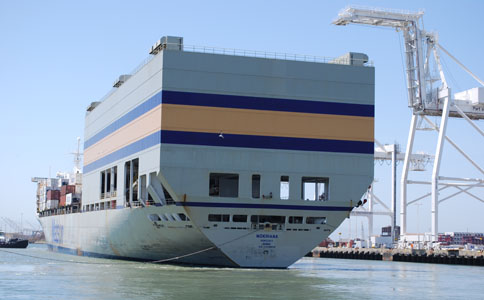Rodolfo R. Sabonge, vice president of market research and analysis with the Panama Canal Authority (ACP), told Bay Area shippers that a wider Panama Canal will pose no threat to the Port of Oakland. In fact, he said, it may bring even more business here.

The Port of Oakland may become an even greater ocean cargo gateway for U.S. exports to Latin America once the Panama Canal Expansion is completed in 2014. Photo by Joel Williams
By Patrick Burnson
Published: July, 2012
Rodolfo R. Sabonge, vice president of market research and analysis with the Panama Canal Authority (ACP), told Bay Area shippers that a wider Panama Canal will pose no threat to the Port of Oakland. In fact, he said, it may bring even more business here.
"The Port of Oakland may become an even greater ocean cargo gateway for U.S. exports to Latin America once the Canal Expansion is completed in 2014," he said.
Sabonge was the featured speaker last week at the "Ports & Terminals" dinner staged annually by the Pacific Transportation Club. Sabonge has been with the Authority since 1986 and has been instrumental in the Canal’s growth and current expansion project.
In his hour-long dinner presentation, Sabonge provided an update on the construction of the third set of locks—an ambitious, eight-year, $5.25 billion engineering and modernization feat that will help double current tonnage capacity.
In addition to being wide enough to fit a 12,000 twenty-foot equivalent unit (TEU) container ship (from the current limit of 4,800 TEU) the new locks will enable larger cruise, tanker, bulk, LNG and ro-ro vessels to use the Panama Canal routing.
"It is one of the largest engineering projects in the world and will significantly impact vessel routings and global trade patterns," he said. "Currently, about 65 percent of the goods transiting the Canal originate from, or are destined to, the United States."
Evidence that Oakland can accommodate the new generation of megavessels was demonstrated earlier this year when one of the world’s largest cargo vessels came into the San Francisco Bay. The MSC Fabiola is part of a new class of container ships creating greater economies of scale, increased fuel efficiency and more service options for shippers.
Of the more than 5,000 containerships deployed around the world, only 71 have a capacity of 12,500 TEUs or more, and the MSC Fabiola is the only one to have regular port calls in the United States. Virtually all vessels in this ultra-large class are deployed in the Asia-Europe trade lane.
Bay Area Air Cargo Shippers
Gain Access to DCA
Bay Area air cargo shippers will have access to Ronald Reagan Washington National Airport (DCA), thanks to the Federal Aviation Administration Modernization and Reform Act of 2012. The flights are a direct result of recently enacted FAA legislation that created eight daily slot exemptions for carriers with limited or no service to Reagan National to fly farther than 1,250 miles from Washington, D.C. Two slots are required for a roundtrip flight.
The ACT—which President Obama signed into law last spring—provides shippers with daily round trip flights from SFO to Reagan. Portland, Ore.; San Juan, Puerto Rico; and Austin also received approval to call Reagan National.
According to U.S. Transportation Secretary Ray LaHood, the services will be performed by Alaska Airlines, JetBlue Airways, Southwest Airlines and Virgin America. This marks Virgin America’s first time flying to Reagan National, with the other carriers previously only having limited access to the Washington, D.C.-based airport.
California Agricultural
Exports Decline
According to an analysis by Beacon Economics, California’s exports of manufactured goods in April nudged up a nominal 0.6 percent from $8.44 billion to $8.49 billion, while non-manufactured exports (chiefly raw materials and agricultural products) fell by 3.7 percent from $1.65 billion to $1.59 billion. Re-exports, meanwhile, rose by 5.5 percent from $2.79 billion to $2.95 billion.
At this time last year, Walter Kemmsies, chief economist for transportation engineering company Moffatt & Nichol, told Bay Crossings that "agriculture was the fastest-growing segment of the next business cycle."
This projection was not challenged by Beacon, however.
"If anything is remarkable it’s that the April numbers were not worse," said Beacon economist Jock O’Connell. "It’s hardly a secret that Europe is in grave distress, that China’s slowing down, and that major economies like Brazil and India have begun going wobbly."
Compounding the challenge for the estimated 60,000 California companies that ship goods to customers around the world, the crisis of the euro has driven up the value of the dollar, effectively making U.S. products more expensive for foreign buyers.
Beacon Economics’ Founding Partner Christopher Thornberg said that with more uncertainty abroad, foreign capital tends to flow to the United States as a safe haven, thereby increasing the value of the dollar and making U.S. exports less competitive on global markets.
"While this trend is not expected to be permanent, the dollar could rise more vis-a-vis the euro until their banking issues are dealt with," said Thornberg. "This could make it somewhat difficult to maintain the pace of export growth that we’ve enjoyed thus far in the recovery."
The news is not unrelentingly dismal, however.
"Probably the best news lately is that our single largest export market, Mexico, remains on a more stable economic footing," O’Connell said, noting that Mexico’s central bank had just last month updated the country’s economic growth outlook for 2012 to a range of 3.25 percent to 4.25 percent.

